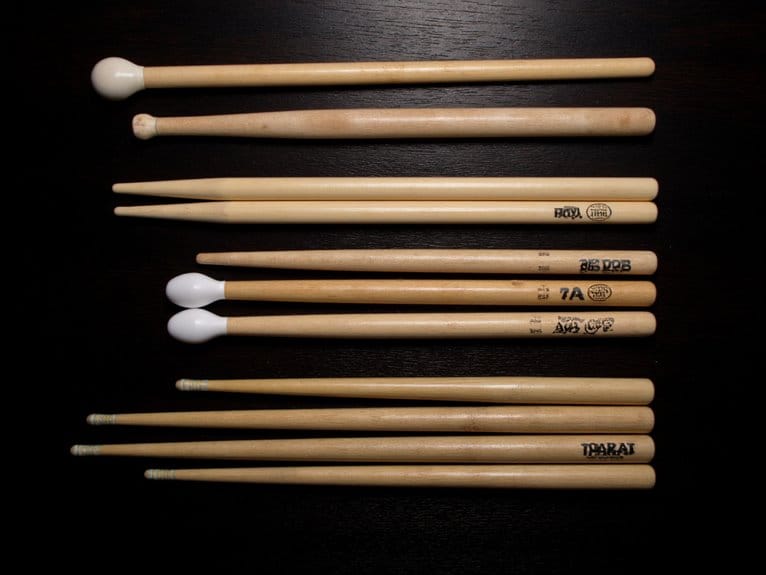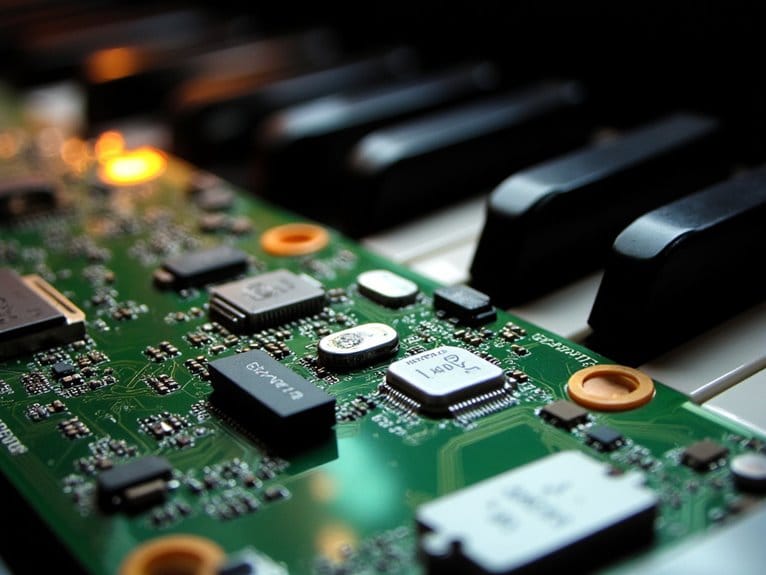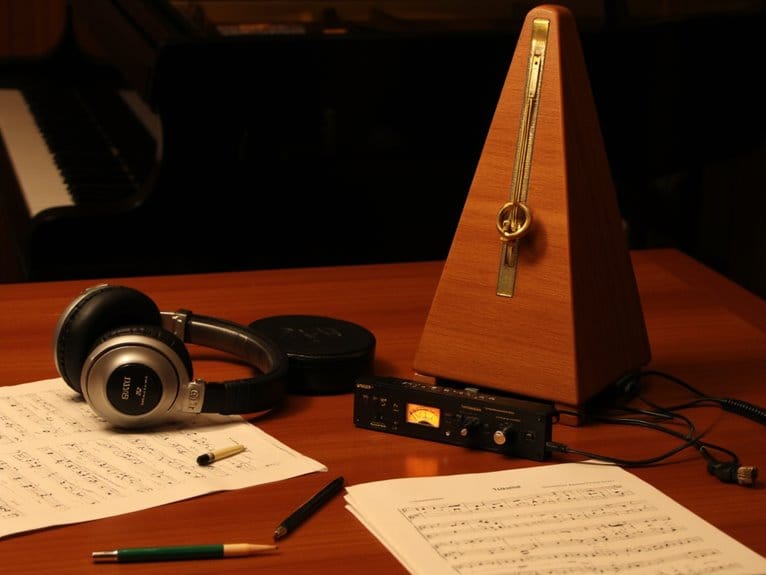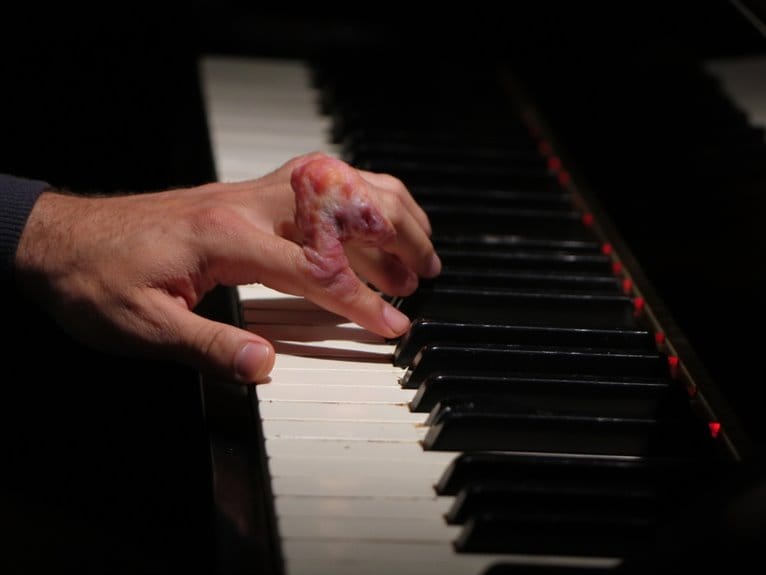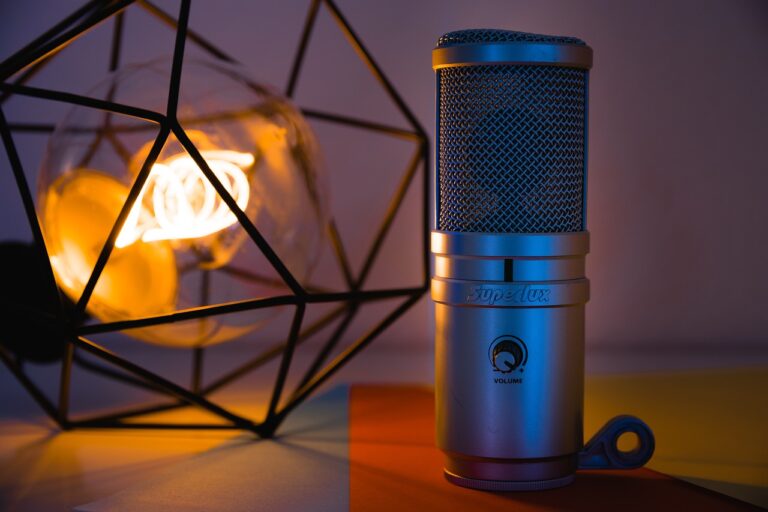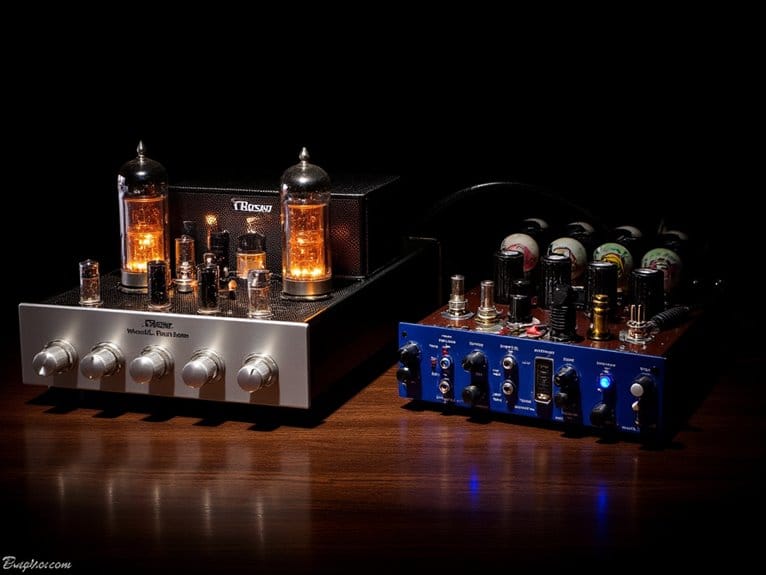Drum Stick Guide: Matching Sticks to Your Playing Style
Your drumstick choice dramatically impacts your performance, with dimensions ranging from 15″ to 17.5″ in length and .55″ to .73″ in diameter affecting reach and control. Jazz players typically prefer lighter 7A sticks with long tapers and oval tips for sensitivity, while rock drummers need heavier 5B models for power and durability. Material matters too-hickory offers durability, maple provides speed, and tip shapes from triangular to ball influence your tone greatly, and exploring these combinations reveals how perfectly matched sticks transform your playing.
We are supported by our audience. When you purchase through links on our site, we may earn an affiliate commission, at no extra cost for you. Learn more.
Notable Insights
- Jazz drummers should choose lighter 7A or 5A sticks with long tapers and oval tips for sensitivity and articulation.
- Rock players need heavier 5B sticks with shorter tapers and pointed tips for power and cutting through dense mixes.
- Stick length affects reach versus control: longer sticks (17.5″) provide extended reach, shorter sticks (15″) offer precise control.
- Material choice impacts durability and feel: hickory balances strength and shock absorption, maple enables faster playing but less durability.
- Tip shape determines tone quality: triangular tips produce bright sounds, oval tips offer balanced response, ball tips ensure uniform articulation.
Understanding Stick Dimensions and Their Impact on Performance
Selecting the right drumstick dimensions isn’t just about grabbing whatever’s available at the music store-I’ve learned through countless hours behind the kit that length, diameter, taper, and tip shape work together like a finely tuned engine to either enhance or hinder your performance.
Stick lengths typically range from 15″ to 17.5″, where longer options provide greater reach for accessing distant toms and cymbals, while shorter variants offer superior control and faster response.
Meanwhile, stick diameters span approximately .55″ to .73″, with thicker sticks delivering more power for rock and metal genres, and thinner options enabling delicate articulation perfect for jazz.
The taper design affects balance and flex, while tip shapes influence your cymbal and drum tones appreciably. A teardrop tip shape yields a warm, dark sound that many drummers prefer for its rich tonal qualities. Just as drummers need precise audio monitoring to hear their performance clearly, the feedback you receive from your sticks impacts your timing and dynamics during practice sessions. The material you choose significantly impacts your playing experience, with hickory being the most common choice due to its strength, while maple offers a lighter and more flexible alternative.
Wood Types and Material Choices for Different Playing Needs
The drumstick material you choose fundamentally shapes your playing experience, sound quality, and wallet-I’ve broken enough sticks over the years to appreciate how wood type affects everything from hand comfort to stick longevity.
Hickory remains the gold standard, offering excellent wood durability and shock absorption that’ll save your hands during marathon sessions.
If you’re after speed and finesse, maple’s 10% lighter weight lets you move faster, though you’ll sacrifice some durability.
Oak delivers serious power for heavy hitters, lasting longer than hickory but transmitting more shock to your hands. Just as heavy hitters benefit from thicker drumheads for increased durability and volume, they’ll appreciate oak’s enhanced longevity despite the trade-off in hand comfort.
For ultimate longevity, aluminum sticks with polyurethane covers provide ten times the lifespan of wood while reducing shock transmission by 50%. These synthetic options offer extremely durable performance that outlasts any wood alternative.
While acoustic drums require physical sticks, modern producers often complement their setups with velocity-sensitive pads that respond dynamically to playing intensity without the wear and tear of traditional sticks.
Tip Shapes and How They Affect Your Sound
Three fundamental tip shapes-triangular, oval, and ball-control whether your cymbals sing with bright clarity or warm darkness, and I’ve spent countless hours experimenting with each to understand how contact area translates into sonic character.
Triangular tips deliver the brightest tones through minimal contact points, though they’ll wear faster under aggressive playing. Oval tips occupy the middle ground, providing fuller frequency response with balanced mids, highs, and lows that work across genres. Ball-shaped tips maintain consistent contact regardless of angle, ensuring uniform articulation every time you strike.
Beyond these basics, acorn tips offer exceptional clarity while teardrop shapes emphasize warm, focused low-end response. Your tip shape choice directly influences tonal characteristics, from barrel tips’ punchy attack to round tips’ clean brightness, making this decision essential for achieving your desired sound. For rock drummers specifically, pointed tips enhance articulation and provide the sharp attack needed to cut through heavy guitar distortion and powerful bass lines.
Taper Design’s Role in Stick Response and Feel
While tip shape determines your initial contact with cymbals and drums, taper design controls how your sticks respond throughout each stroke, fundamentally altering the balance, rebound characteristics, and overall feel that shapes your playing experience.
The taper advantages become apparent when you consider how this design element shifts your stick’s center of gravity. Longer tapers move the balance point toward the tip, creating that lighter, more responsive feel that jazz drummers love, while shorter tapers provide the front-heavy power that rock players crave.
Taper design fundamentally shifts stick balance-longer tapers create jazz-friendly responsiveness while shorter tapers deliver the front-heavy power rock drummers demand.
- Rebound flexibility increases dramatically with longer tapers, allowing your sticks to flex more upon impact for quicker, more natural rebounds.
- Balance shifts affect your technique, with tip-heavy sticks favoring speed and control versus shoulder-heavy sticks delivering raw power.
- Durability trades off against responsiveness, as thinner tapered sections sacrifice longevity for enhanced finesse and dynamic control.
Understanding how stick response interacts with cymbal characteristics becomes crucial when developing your sound, as stick definition varies significantly depending on whether you’re playing hand-hammered bronze cymbals or entry-level brass models.
Specialized Sticks for Specific Musical Styles and Venues
When I’ve spent time observing drummers across different musical genres, I’ve noticed that choosing the right stick isn’t just about personal preference-it’s about matching your tools to the specific demands of your musical style and performance environment.
Jazz stick characteristics typically favor lighter, thinner models like 7A or 5A (.540″-.565″ diameter) with long tapers and oval tips for nimble, delicate playing and warmer cymbal tones.
Rock stick requirements demand heavier options like 5B (.595″) or metal sticks (.630″-.635″) for power and durability during aggressive playing.
Marching stick specifications call for much thicker diameters (.660″-.710″) to project outdoors, while acoustic stick preferences lean toward sensitive, thinner sticks that respond to subtle dynamics in intimate venues.
Frequently Asked Questions
How Often Should I Replace My Drumsticks?
Your drumstick lifespan depends on playing frequency and intensity. You’ll replace them every few months as a beginner, while heavy hitters might need new sticks after each show due to breakage and wear.
Can I Use Different Stick Types Simultaneously During One Performance?
You can absolutely use different stick combinations during one performance. Hold mallets in one hand and traditional sticks in the other, or use hybrid sticks with dual tips for performance versatility and expanded sonic textures.
Should Beginners Start With Cheaper Sticks or Invest in Quality Ones?
Start with cheaper sticks while learning since you’ll break them frequently. Budget considerations matter early on, but don’t sacrifice too much stick durability. You can upgrade to quality sticks once your technique improves.
How Do I Know When My Drumsticks Are Worn Out?
You’ll notice key wear indicators like fraying, chipping, or splinters on tips and shafts. Regular stick maintenance includes checking for cracks, balance changes, and sharp edges that could damage drumheads or cause injury.
On a final note
You’ve now got the roadmap to finding your perfect drumstick match, and honestly, it’s one of those gear decisions that’ll make more difference than you’d expect. Don’t overthink it though-grab a few pairs that align with your style and venue needs, test them during actual playing sessions, and you’ll quickly discover which combination of dimensions, materials, and tip shapes feels right under your hands.

